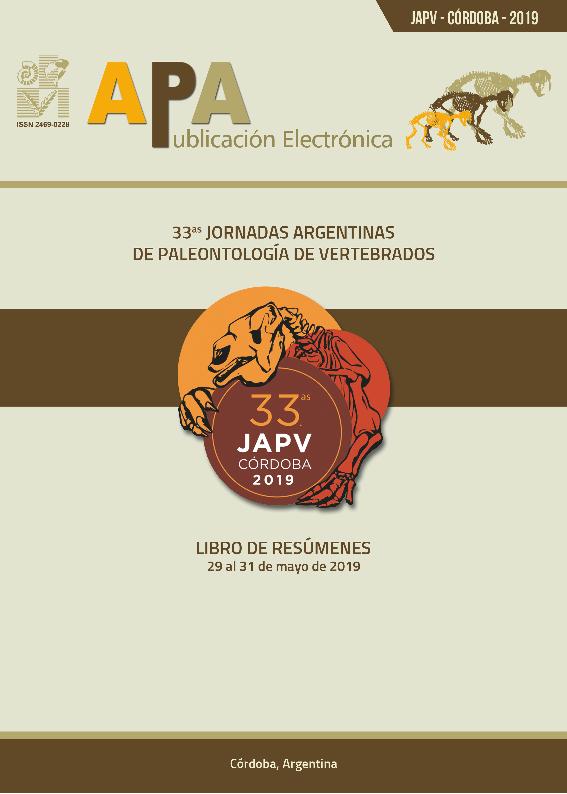Evento
A new fairy armadillo (Cingulata, Chlamyphoridae) from the late Miocene of Argentine Pampas: first fossil record of the most enigmatic Xenarthra
Barasoain Goñi, Daniel ; Tomassini, Rodrigo Leandro
; Tomassini, Rodrigo Leandro ; Zurita, Alfredo Eduardo
; Zurita, Alfredo Eduardo ; Montalvo, Claudia Inés; Superina, Mariella
; Montalvo, Claudia Inés; Superina, Mariella
 ; Tomassini, Rodrigo Leandro
; Tomassini, Rodrigo Leandro ; Zurita, Alfredo Eduardo
; Zurita, Alfredo Eduardo ; Montalvo, Claudia Inés; Superina, Mariella
; Montalvo, Claudia Inés; Superina, Mariella
Tipo del evento:
Jornada
Nombre del evento:
33as Jornadas Argentinas de Paleontología de Vertebrados
Fecha del evento:
29/05/2019
Institución Organizadora:
Universidad Nacional de Córdoba. Facultad de Ciencias Exactas Físicas y Naturales. Museo de Paleontología;
Agencia Córdoba Cultura. Museo de Ciencias Naturales Dr. Arturo Umberto Illia;
Consejo Nacional de Investigaciones Científicas y Técnicas. Centro de Investigaciones en Ciencias de la Tierra;
Título de la revista:
Publicación Electrónica de la Asociación Paleontológica Argentina
Editorial:
Asociación Paleontológica Argentina
ISSN:
2469-0228
Idioma:
Inglés
Clasificación temática:
Resumen
Recent reassessments of the systematic schemes of Cingulata, mainly based on molecular analyses, point out that its evolutionary history could be more complex than previously believed. An ancient divergence, ca. 45 Ma, was proposed for armadillos, recognizing two large monophyletic groups, Dasypodidae (including Dasypodinae) and Chlamyphoridae (including Euphractinae, Tolypeutinae, and Chlamyphorinae). Extant species included within Chlamyphorinae (fairy armadillos), Chlamyphorus truncatus Harlan, 1825, and Calyptophractus retusus Burmeister, 1863, are among the most bizarre, elusive and unknown mammals of the world, probably due to their strict fossorial behavior. Molecular data suggested the divergence of both species at ca. 17 Ma, coinciding with a marine ingression that could have stimulated cladogenesis. Here we report the first accurate fossil record of this enigmatic subfamily, coming from the Late Miocene (Arroyo Chasicó Formation; ~9 Ma) of the Argentine Pampas (southern Buenos Aires province), which represents a new genus and species. Materials (MMH-CH-87-7-100) include fixed and mobile osteoderms of the dorsal carapace, part of the rump plate, left hemimandible with complete dental series and other postcranial remains. The presence of a rump plate, ornamentation pattern and dental features allow including the fossil specimen within Chlamyphorinae. The size (~40% bigger than the extant species), larger thickness of the osteoderms and morphology of the rump plate, point towards a new taxon. The phylogenetic analysis carried out reflects the monophyly of the three known chlamyphorines, well supported by several unambiguous synapomorphies, and, in addition, includes the new fossil taxon as a sister group of the two extant species.
Palabras clave:
CHLAMYPHORIDAE
,
LATE MIOCENE
,
XENARTHRA
,
NEW GENUS AND SPECIES
Archivos asociados
Licencia
Identificadores
Colecciones
Eventos(INGEOSUR)
Eventos de INST.GEOLOGICO DEL SUR
Eventos de INST.GEOLOGICO DEL SUR
Citación
A new fairy armadillo (Cingulata, Chlamyphoridae) from the late Miocene of Argentine Pampas: first fossil record of the most enigmatic Xenarthra; 33as Jornadas Argentinas de Paleontología de Vertebrados; Córdoba; Argentina; 2019; 4-4
Compartir
Altmétricas



